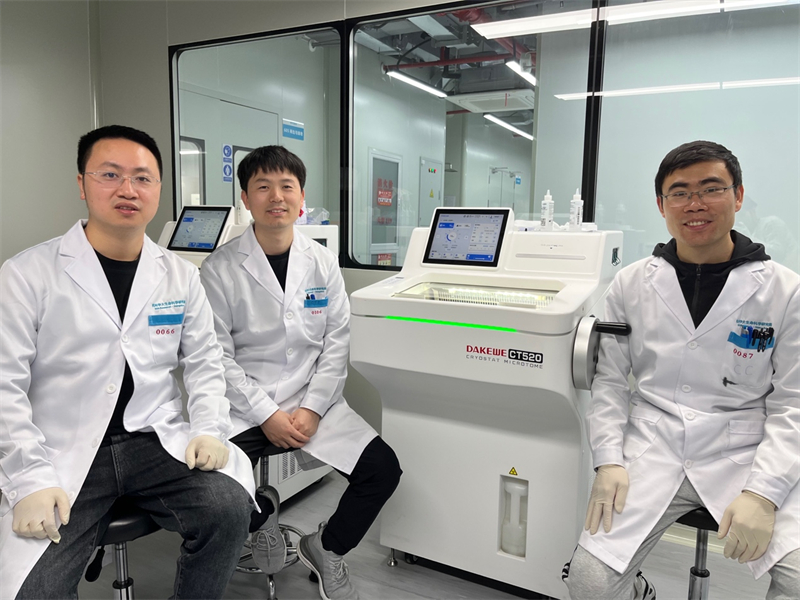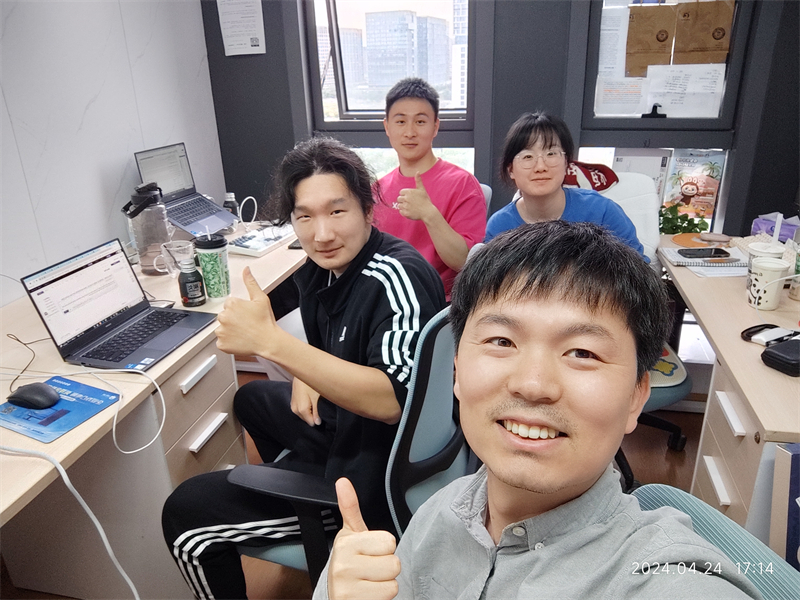- CN
Nov 01, 2024

2024 is a busy year for Dr. Hao Shijie, a Postdoctoral Researcher at BGI-Research.
On September 26, a new study examining the single-cell spatial transcriptomic atlases of the cross-species cerebellar cortex was published in Science, with Dr. Hao as one of the co-first authors. This comes just five months after two papers on liver function that he contributed to were published in Nature Genetics.
 Dr. Hao Shijie, a Postdoctoral Researcher at BGI-Research (middle), together with his colleagues in a lab. (Courtesy of Dr. Hao Shijie.)
Dr. Hao Shijie, a Postdoctoral Researcher at BGI-Research (middle), together with his colleagues in a lab. (Courtesy of Dr. Hao Shijie.)
Dr. Hao’s academic journey began with his studies in Bioinformatics at Southeast University in China. In his senior year, he had the opportunity to intern at BGI-Research through a joint training program between BGI and his university. It was there that he started his career as a scientist working on plant and animal genomics. “I liked it because it was exploratory - and kind of fun,” he recalls.
Dr. Hao decided to continue his academic training by pursuing both his master's and doctoral degrees through the UCAS BGI Special Program, believing his passion lay in scientific research. Through the program, he met his mentor, Dr. Liu Longqi, Chief Scientist of Cell Omics at BGI-Research, and began collaborating on developing BGI’s spatial transcriptomics technology, Stereo-seq, and its applications.
True scientific achievement doesn’t come easy. One of Dr. Hao’s most memorable experiences was the long, but meaningful, hours of overtime he spent with his team. It was during this time that he started to understand what it really meant to work as a professional scientist.
“While we were working on the Stereo-seq technology paper, we operated out of a meeting room that could fit about 10 to 20 people. Everyone was under tremendous pressure, working late into the night every day - it became routine for all of us,” Dr. Hao recalls. “During these long hours, when Dr. Liu saw that the team was exhausted, he’d play the guitar and sing for everyone to boost morale.”
The technologies Dr. Hao has helped develop have since been applied to a range of scientific studies, including liver regeneration, neuroscience, and aging-related research. Of particular note, Dr. Hao and his team applied Stereo-seq to study liver function.
“The liver has the ability to regenerate,” he explains. “When some liver cells lose function due to disease, the dysfunctional tissue can be surgically removed, and the remaining liver initiates a regeneration process, restoring its original size. However, this regeneration process and its genetic regulation are still not fully understood. Studying liver regeneration after injury can provide valuable insights.”
Dr. Hao believes that the greatest advantage of Stereo-seq technology is its ability to resolve unique structures within tissues. The liver, in particular, exhibits fascinating spatial heterogeneity. By applying Stereo-seq, the team was able to study the gene expression and organ function in the liver, offering insights that could help guide treatments for liver diseases.
Right after the liver study was published, a new opportunity arose. BGI-Research and the Center for Excellence in Brain Science and Intelligence Technology (Institute of Neuroscience) at the Chinese Academy of Sciences launched a strategic project to create a spatiotemporal atlas of the brain.
When his mentor encouraged him to join the project, Dr. Hao hesitated. It would mean changing his research direction and diving into an entirely new field.
“One day, Dr. Liu gathered all of us for a meeting. He spoke sincerely about the unique evolution of the mammalian brain, the complex web of neuronal connections, and the importance and future potential of brain science research,” Dr. Hao recalls. The meeting lasted for hours, and eventually, Dr. Hao was convinced. “Looking back now, Dr. Liu’s vision was extraordinary. His grasp of where scientific research was headed was incredibly accurate.”
So, Dr. Hao embarked on a new journey into brain research. Alongside nearly 100 researchers from BGI-Research, the Institute of Neuroscience at the Chinese Academy of Sciences, and other institutions, the team successfully created comprehensive single-cell spatial transcriptomic atlases of the cerebellar cortex across multiple species. By analyzing gene expression patterns within these atlases, scientists can better understand how different cell types interact to perform the cerebellum's diverse functions. Additionally, these atlases can help identify potential mechanisms of disease, as diseases often trigger abnormal gene expression changes that can be detected through the atlases.
One of the most rewarding aspects of this project was the cross-disciplinary collaboration. “Working with people from other disciplines brought entirely new perspectives and tools to my research. Learning from their methods made my own research much more interesting,” Dr. Hao says.
 Dr. Hao Shijie (front) with the core members of the cross-species cerebellar cortex research team. (Courtesy of Dr. Hao Shijie.)
Dr. Hao Shijie (front) with the core members of the cross-species cerebellar cortex research team. (Courtesy of Dr. Hao Shijie.)
For example, while conducting brain science research, team members from the Institute of Neuroscience used medical imaging techniques to gather data. They scanned mammalian brains using fMRI (functional magnetic resonance imaging) to study functional connectivity, while BGI-Research's team focused on single-cell genomics to understand the cellular structures and gene expression underlying that connectivity.
“The combination of these two disciplines is really fascinating,” Dr. Hao says. “It delivered refreshing, eye-opening results.”
Today, as a postdoctoral researcher at BGI-Research, Dr. Hao has become the full-fledged scientist he always dreamed of being. He credits his success to the rich resources and opportunities for young scholars that BGI offers. “At BGI, the research directions are incredibly diverse. You can work on genomics, digitizing life, or dive into single-cell genomics to explore disease mechanisms, development, aging, and more - all of which satisfy different scientific curiosities - and I think that’s truly remarkable."
“I think anyone who aspires to make an impact in life sciences will be drawn to these opportunities.”